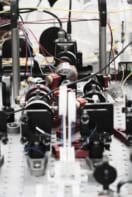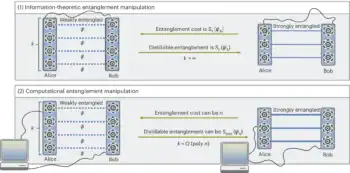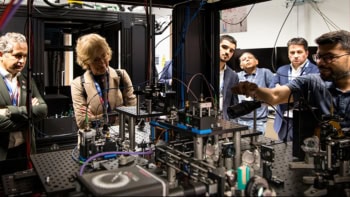Physicists in the US have taken another important step towards making a quantum computer. Duncan Steel of the University of Michigan and co-workers have created a logic gate using two electron-hole pairs - also known as “excitons” - in a quantum dot (X Li et al. 2003 Science 301 809).

Classical computers deal with binary logic and the bits being processed must be either “0” or “1”. Quantum computers, on the other hand, exploit the ability of quantum particles to be in two or more states at the same time. A quantum bit or “qubit” can therefore be “0” or “1” or any combination of the two. This means that a quantum computer could, in principle, outperform a classical computer for certain tasks. However, all the quantum computers demonstrated so far have only contained a handful of qubits.
Although qubits have been made with trapped photons, atoms and ions, it is generally thought that it should be easier to build working devices with solid-state systems. Several teams have made significant progress with the superconducting approach to solid-state quantum computing. Now Steel and co-workers at Michigan, Michigan State, the Naval Research Laboratory and the University of California at San Diego have demonstrated the first all-optical quantum gate in a semiconductor quantum dot.
Steel and co-workers grew a thin gallium arsenide layer 4.2 nm thick between two 25 nm aluminium gallium arsenide barriers to make a quantum dot. Electrons are trapped in the dot because the gallium arsenide layer has a smaller energy band-gap than the surrounding material. When excited by light, electrons from the valence band in the dot move to higher energy levels. The excited electron and the ‘hole’ it leaves behind combine to form an exciton. The system has four states: a ground state containing two unexcited electrons; two states containing one exciton; and a state containing two excitons (see figure). The two single-exciton states can be distinguished from each other because the excitons have different polarizations.
The researchers showed that they can drive Rabi oscillations between the ground state and the one-exciton states, and also between the one-exciton states and the biexciton state, with lasers. In particular they showed that the quantum-dot system behaves like a controlled-NOT gate in which the value of one qubit is reversed (the NOT operation) if – and only if – the value of the other qubit is 1.
Although it will not be possible to scale up the system, the group says that many of the ideas and techniques they have developed could be useful in other approaches to quantum computing based on the optical control of electron-spin qubits in quantum dots.



